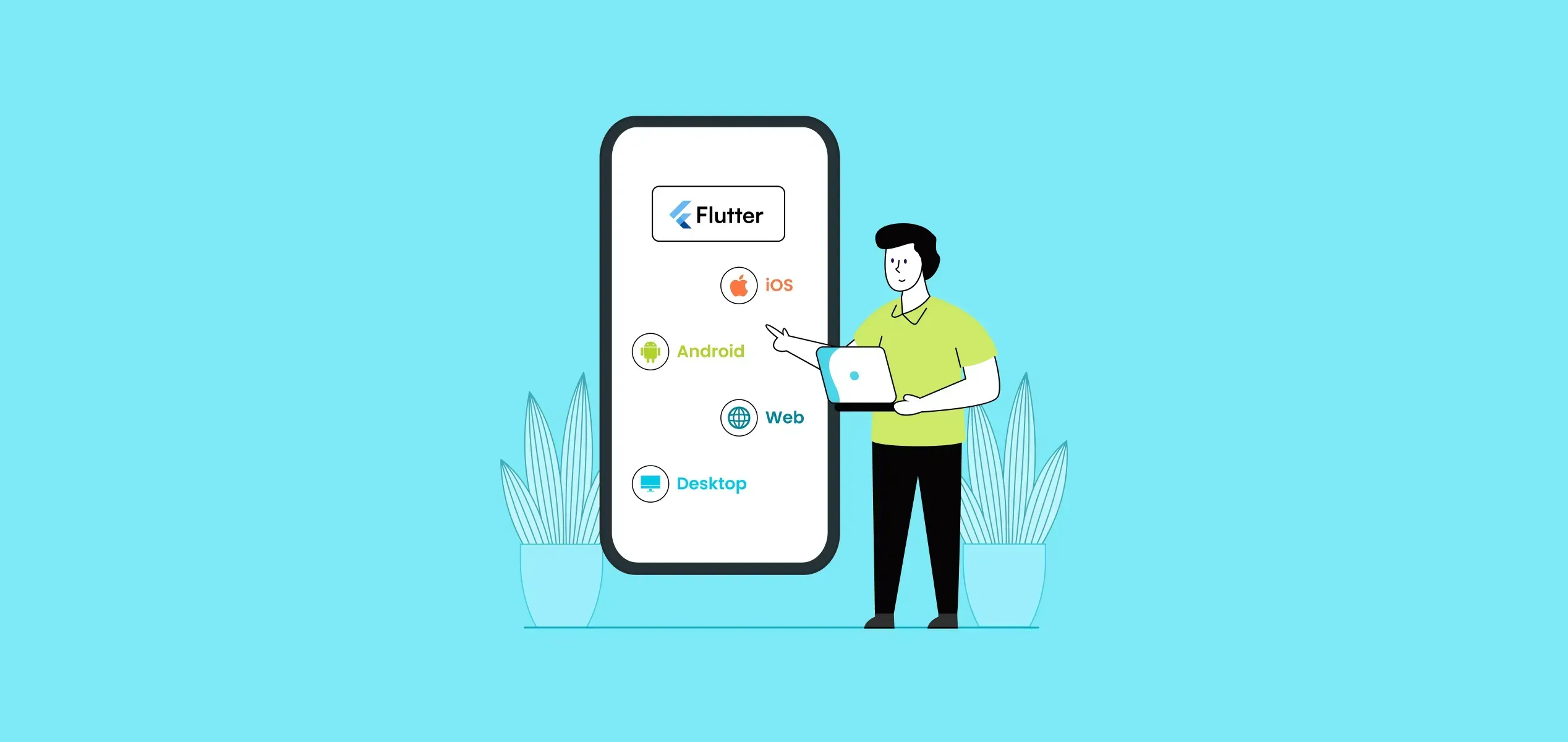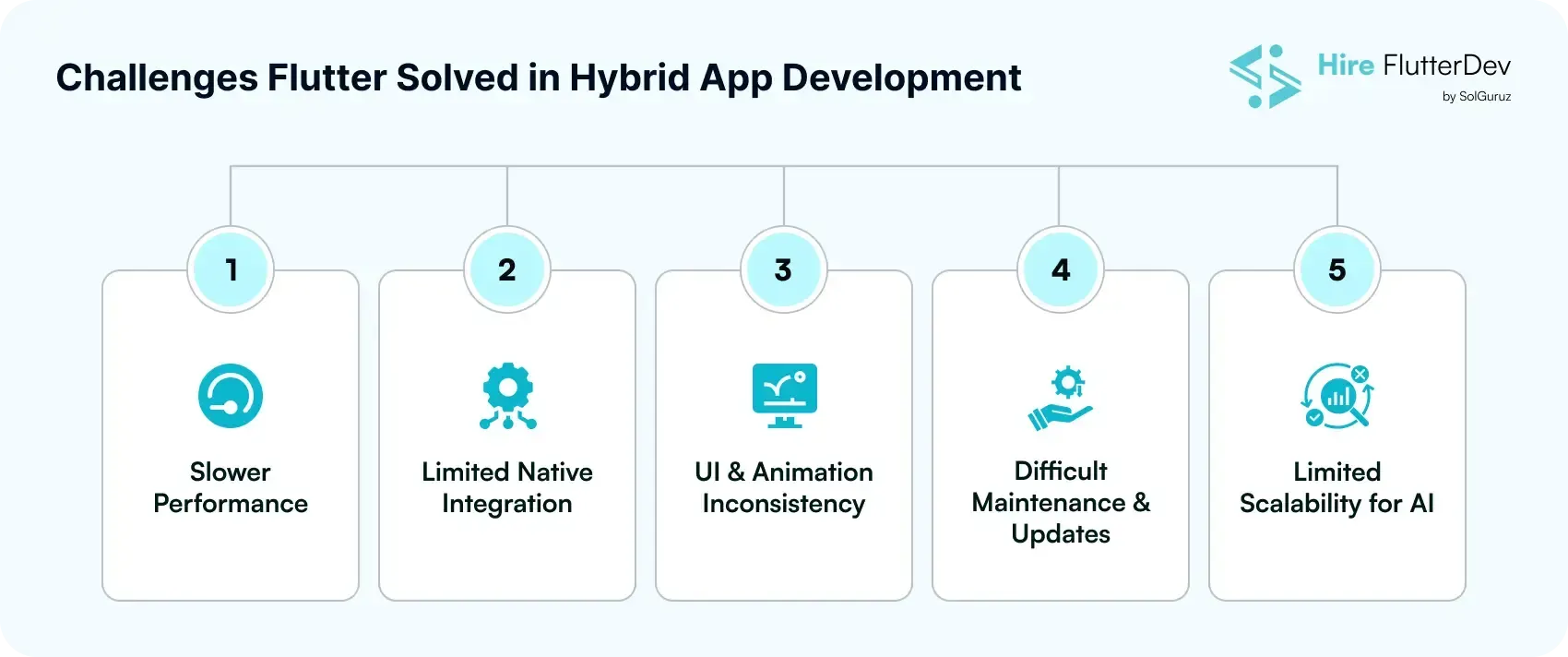
The final deployment of the project deadline was two weeks away, and my client’s hybrid app was lagging, smooth on Android, broken on iOS.
Every time a bug was fixed, a new problem occurred. The pressure was creating real chaos in the team.
It was the main reason I thought to rebuild the app from scratch, this time with Flutter for hybrid app development.
Within just nine days, the difference was night and day.
The app was more stable, faster, and delivered a truly native feel across platforms.
That project didn’t just save our deadline; it changed how I build apps forever.
Let me help to understand how and why Flutter is used for Hybrid app development at the core.
In the world of hybrid mobile app development, apps are created using standard web technologies like HTML, CSS, and JavaScript, and then stay within a native container
In short:
Let's see the quick comparison between hybrid apps and native apps:
Feature | Hybrid Apps | Native Apps |
Codebase | Single | Separate for iOS & Android |
Performance | Moderate (WebView-based) | High (Native APIs) |
UI Consistency | Limited | Excellent |
Cost | Affordable | Expensive |
Development Speed | Fast | Slower |
The problem?
Hybrid apps traditionally used to look more like web apps instead of native ones.
That’s where Flutter took the entry and changed the game completely.
Many of you have a myth in mind that hybrid apps and cross-platform apps are the same, right? But that's not the case. Here is the difference between the two of them:
Flutter is technically a cross-platform mobile app development framework,
But since it builds once and it runs everywhere, and is more usually viewed as the next game changer of hybrid frameworks.
This is the main reason why Flutter is called the bridge between hybrid and native worlds.

Yes, Flutter is the future, but how?
As it is supported by Google, it’s more than an SDK; it's a future-ready framework that combines native performance, scalability, and next-gen technologies like AI and Generative AI.
With Flutter's single codebase method, you can adjust the UI and logic for each platform without rewriting the code. This results in faster updates, reduced QA effort, and a consistent user experience, one of the biggest advantages in Flutter app development.
Flutter enables developers to add AI-focused features like chatbots, predictive analytics, and personalised ones.
The flexibility of Flutter with APIs and backends allows you to embed GenAI-powered features, for example, code suggestions, text summarization, voice assistants, and more into your hybrid apps.
Flutter’s FFI, also known as Foreign Function Interface, enabled direct integration with native C/C ++ libraries or existing ML models, reducing performance-based issues. Heavy AI computations or data encryption locally can be run by developers without cloud dependency.
Through Flutter, you can do faster integration with the most used backend services. It enables you to create scalable hybrid apps with real-time databases.
Flutter now has improved performance with the Impeller rendering engine, which was introduced in Flutter 3.13+. It is better than Skia as it delivers smooth 3D graphics and shader compilation, mostly suitable for gaming.
Flutter is widening its capabilities; for example, due to its lightweight architecture, it now supports IoT and embedded systems, going from car dashboards to smart home systems.
Key Note - With 40–50% faster development cycles and 60% lower maintenance costs, Flutter is redefining how modern hybrid apps are built. These advantages are a major reason why leading Flutter app development companies adopt Flutter to deliver high-performance, scalable, and cost-efficient digital products.
Now, moving ahead, I will show you the ultimate comparison between traditional hybrid frameworks vs Flutter.
Factors | Traditional Hybrid Frameworks | Flutter |
Core Tech | WebView (HTML/CSS/JS | Dart + Native Rendering |
Performance | Moderate | Near-Native |
UI Consistency | Browser-dependent | Consistent across devices |
Access to Native APIs | Limited | Extensive |
Development Time | Moderate | Faster (Hot Reload |
Thus, from the above comparison table, it has been observed that traditional frameworks, such as Ionic and Cordova, form the main foundation. Still, Flutter is redefining hybrid app development with native rendering, scalability, and modern UI frameworks.

One major rationale why Flutter for hybrid app development is chosen due to its powerful three-layered architecture. Unlike traditional hybrid frameworks, Flutter reduces web-view dependency, improves speed, smooth rendering, and provides strong stability.
The embedded forms the main layer of every Flutter app, making it connected with all platforms like desktop, iOS, or Android. However, it manages input handling, app lifecycle, rendering surfaces, and other low-level tasks, making it more convenient for mobile app developers to build apps that behave natively on all devices.
As we know Flutter engine is written in C++, making it faster and the main heart of the overall framework. It manages graphics rendering, text layout, animations, and runtime execution using technologies like:
Dart is used for building the Flutter framework. It is where the real developers work, create user interfaces, manage state, and add/modify logic via an extensive widget library. It gives dedicated Flutter developers complete creative control to create pixel-perfect apps that perform everywhere with no lag.

Selecting the right framework is not only about saving costs, but it’s also about launching faster, scaling smarter, and innovating at a continuous level. That’s exactly why businesses in 2026 are choosing Flutter. Here are the main reasons why entrepreneurs are still investing in it and why many now choose to hire Flutter app developers for their hybrid projects:
Flutter gives you speed due to its hot reload and parallel development workflow. Teams can easily launch prototypes, MVPs, and productions faster without sacrificing quality.
With its unified widget system, Flutter ensures your apps look like same across all platforms, across desktop, web, iOS, and Android. So, yes, brand consistency across all platforms is well-maintained by Flutter, consistent UI everywhere.
You do not have to hire a separate additional team as Flutter allows developers to work on one codebase, with multiple platforms, minimising both initial build and maintenance costs. Not only that, it gives faster market entry and seamless updates, which result in higher ROI and faster customer acquisition.
Flutter is best known for scaling from MVPs to enterprise platforms, and it supports expansion for the long term. Over time, as your base grows, you can expand the functionality, integrate advanced APIs, or shift to AI and IoT features without rework.
Nowadays, everyone wants apps that can think, adapt, and provide personalized content. Flutter can integrate with AI and ML, such as TensorFlow or OpenAI, providing help to brands to build smart hybrid apps that improve user engagement.
Remember: Not only for development, but Flutter aims to build future-ready apps that scale, adapt, and perform without any lag across every platform. If you're looking for a top notch flutter app development company, focus on doing in-depth research to hire service providers.

Before Flutter, hybrid development faced four persistent challenges, and Flutter solved them all.
Due to webview, old hybrid apps mostly had to face slow rendering and delayed responses, making it difficult to work. But Flutter’s Dart runtime compiles directly to native code, ensuring smooth animations, no lag, and higher speed.
Plugins were needed in older hybrid apps and along with workarounds for accessing the camera, GPR, or notifications. Flutter’s platform channels provide you with seamless communication and give complete access to hardware and OS level APIs.
Earlier, UIs were to be rendered differently by frameworks across different devices, making it difficult to maintain consistency. Flutter’s custom rendering engine ensures consistent visuals across all devices.
To maintain hybrid apps, testing was needed at every stage and across multiple platforms manually. But Flutter made it simple by using an approach of a single unified codebase and automation testing.
It was not easy for traditional frameworks to work as per modern requirements. But with the introduction of Flutter, it works well and fast with tools such as TensorFlow Lite and OpenAI APIs, making it more convenient to add smart features like real-time insights, personalization, and more. This is one reason why many Flutter app development companies prefer Flutter for building fast, AI-powered applications.
Here, I will now explain when and not to use Flutter for hybrid development. Let's dive in to make it clear.
Scenario | When you need Flutter |
For Multiplatforms | Looking to make apps cross different platforms, such as Android, iOS, and web, then Flutter gives you a single codebase-like feature. |
High Performance Without Native Costs | With Flutter, you get massive speed as it compiles directly to native ARM code, providing a boost in performance at a very low cost, in contrast to full development cost. |
Consistent, Modern UI Across Devices
| Through Flutter widgets, consistency can be maintained effectively whether it is Android or iOS platform with a single codebase concept. |
The aim is for Mobile, Web, and Desktop Users. | Flutter is not only used for building mobile apps, but it's a multiplatform SDK. With this, you can enhance your user base at a wider level. |
Long-Term Scalability and Support | If you aim to expand app features, integrate with AI/ML, Flutter architecture, and, as it is supported by Google, make it future-ready. |
Reliability and a Future-Proof Stack | Long-term stability, security, and compatibility are provided by Flutter as it has a larger community globally.
|
We all know how fast the technologies and preferences for app development are changing, right?
The ongoing demand for Flutter hybrid development is making it easier for developers to compile native and cross-platform applications with better efficiency. It delivers you with higher speed, complete flexibility, and UI widgets.
Traditionally, hybrid frameworks helped businesses reach users faster, but Flutter took that goal to the next level, allowing for higher-performing apps with beautiful UIs, AI-powered widgets, and more advanced features.
At Hire Flutterdev, we aim to change ideas into robust digital products with Flutter development services.
Our experienced Flutter developers drive market-ready products that are fast, accurate, and AI future-enabled.
Definitely, Flutter is better than react native when the focus is on hybrid app development. After all, it allows having native code and is not dependent on a WebView.
Yes, Flutter apps do deliver with higher performance as it uses Dart runtime and rendering engine, which compiles directly to native ARM code, assuring near native speed and better response.
Flutter reduces the development cost as it provides works with method of single codebase, which enables developers to develop for all different types of platforms, minimising the need for hiring additional teams and saving time as well as money.
Yes, many companies use Flutter for enterprise-level hybrid applications since it is secure and can be integrated with enterprise tools, APIs, and other cloud platforms like Azure. AWS.
Hire Flutterdev has experience in developing high-performance and cross-platform Flutter apps that provide measurable business results. Our dedicated professionals ensure your app is faster and future-ready for deployment.
Let’s begin a collaborative journey together where we craft Flutter applications that set benchmarks for you.